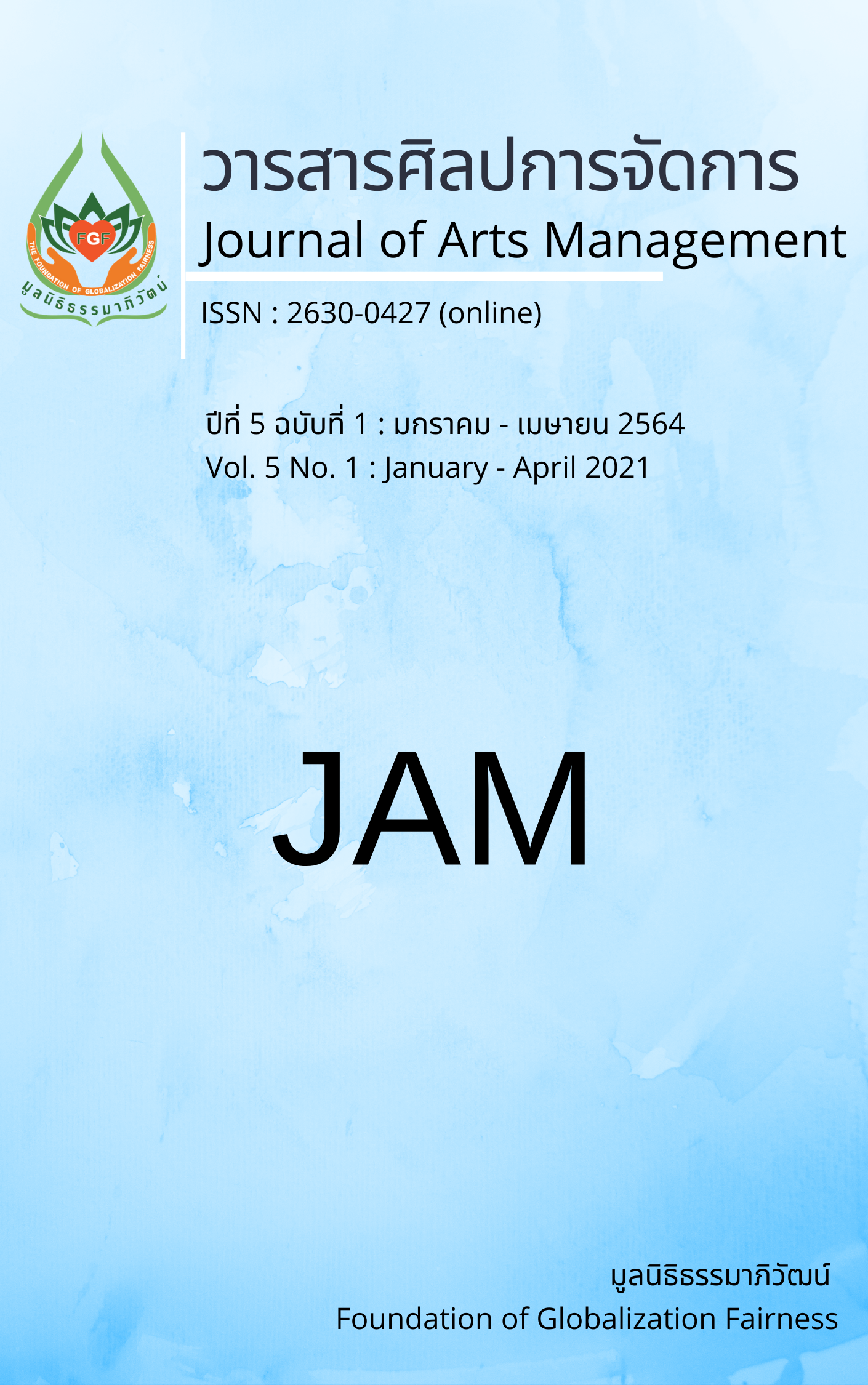Antecedents Affecting Employee Retention of Medical Personnel in a Standard Level General Hospital Under The Ministry of Public Health
Main Article Content
Abstract
The objectives of this research were 1) to study the levels of motivation factors, hygiene factors, job satisfaction, organizational commitment, and job retention of medical personnel in a standard level general hospital under The Ministry of Public Health, and 2) to study the effects of motivation factors, hygiene factors, job satisfaction and organizational commitment on job retention of medical personnel in a standard level general hospital under The Ministry of Public Health. The samples were 223 medical personnel. A questionnaire survey was a data collection tool. The data analysis employed descriptive statistics including frequency, percentage, mean and standard deviation and inferential statistics using partial least squares structural equation modeling (PLS-SEM). Determined existence of multicollinearity with variance inflation factors (VIF). Reflective measurement model assessment using Cronbach’s α, composite reliability, and outer loadings. Then tested convergent and discriminant validity of the measurement model. The results indicated that: motivation factors, hygiene factors, job satisfaction, organizational commitment, and job retention levels were at high levels. While motivation factors have no direct positive relationship with job retention. On the other hand, there were direct positive relationships from hygiene factors, job satisfaction, and organizational commitment on job retention at the statistically significant level as of 0.05.
Article Details
Views and opinions appearing in articles in the Journal of Arts of Management It is the responsibility of the author of the article. and does not constitute the view and responsibility of the editorial team I agree that the article is copyright of the Arts and Management Journal.
References
กมลพร กัลยาณมิตร. (2559). แรงจูงใจ 2 ปัจจัย พลังสู่ความสำเร็จ. วารสารวไลยอลงกรณ์ปริทัศน์ (มนุษยศาสตร์และสังคมศาสตร์), 6(3), 175-183.
กฤษฏ์ เติมทิพย์ทวีกุล และกฤษดา เชียรวัฒนสุข. (2562). บุพปัจจัยที่ส่งผลต่อการคงอยู่กับองค์กรของช่างเทคนิคและวิศวกรในอุตสาหกรรมพลาสติกขนาดกลางและขนาดย่อม: กรณีศึกษาโรงงานอุตสาหกรรมพลาสติกในจังหวัดปทุมธานี. วารสารสันติศึกษาปริทรรศน์ มจร., 7(3), 823-837.
กฤษดา เชียรวัฒนสุข. (2563). หลักการจัดการและองค์การ. กรุงเทพฯ: ทริปเพิ้ล เอ็ดดูเคชั่น.
จุไรวรรณ บินดุเหล็ม. (2562). ปัจจัยที่มีความสัมพันธ์กับความตั้งใจคงอยูในงานของข้าราชการและลูกจ้างองค์การบริหารส่วนจังหวัดสงขลา (สารนิพนธ์ปริญญารัฐประศาสนศาสตรมหาบัณฑิต สาขาวิชารัฐประศาสนศาสตร์). มหาวิทยาลัยสงขลานครินทร์.
ชนม์ภิชา นาคโร. (2563). ความสัมพันธ์ระหว่างการรับรู้ความยุติธรรมในองค์การ สัมพันธภาพกับหัวหน้างาน และพฤติกรรมการเป็นสมาชิกที่ดีขององค์การ ของพนักงานบริษัทเอกชนแห่งหนึ่ง โดยมีความผูกพันกับองค์การ เป็นตัวแปรกำกับ. วารสารมนุษยศาสตร์และสังคมศาสตร์ วไลยอลงกรณ์ ในพระบรมราชูปถัมภ์, 15(2), 83-98.
ณิชพร คำเถียร. (2559). แรงจูงใจกับการทำงานเป็นทีมของข้าราชการครู ในโรงเรียนสังกัดกรุงเทพมหานคร (วิทยานิพนธ์ปริญญาศึกษาศาสตร์มหาบัณฑิต สาขาวิชาการบริหารการศึกษา). มหาวิทยาลัยศิลปากร.
ธนัญพร สุวรรณคาม. (2559). ปัจจัยด้านแรงจูงใจในการทางาน ความพึงพอใจในงานที่ส่งผลต่อความผูกพันต่อองค์การของพนักงานธนาคารพาณิชย์แห่งหนึ่ง (วิทยานิพนธ์ปริญญาศิลปศาสตรมหาบัณฑิต สาขาวิชาจิตวิทยาอุตสากรรมและองค์การ). มหาวิทยาลัยธรรมศาสตร์.
ธานินทร์ ศิลป์จารุ, (2553). การวิจัยและวิเคราะห์ข้อมูลทางสถิติด้วย SPSS. (พิมพ์ครั้งที่ 11). กรุงเทพฯ: บิสซิเนสอาร์แอนด์ดี.
นันทวดี อุ่นละมัย และกฤษดา เชียรวัฒนสุข. (2562). แรงจูงใจใฝ่สัมฤทธิ์ที่มีผลต่อผลการปฏิบัติงานและการคงอยู่ในองคฺกรของพนักงานมหาวิทยาลัยสายสนับสนุน กรณีศึกษา มหาวิทยาลัยเทคโนโลยีราชมงคลธัญบุรี. วารสารการวิจัยการบริหารการพัฒนา, 9(3), 126-138.
ปฐมา ธรรมชัยภูมิ. (2561). ปัจจัยทำนายการคงอยู่ในงานของพยาบาลวิชาชีพกลุ่มวัย วาย ที่โรงพยาบาลระดับตติยภูมิ แห่งหนึ่งในจังหวัดปทุมธานี. วารสารโรงพยาบาลเจริญกรุงประชารักษ์. 14(2), 25-34.
วารุณี มิลินทปัญญา. (2561). ปัจจัยที่สัมพันธ์กับการคงอยู่ในงานของบุคลากรโรงพยาบาล มหาวิทยาลัย. Journal of Humanities and Social Sciences Thonburi University, 12(28), 244-255.
วิภาวรรณ จรัสกุล. (2560). ภาวะผู้นำกับความผูกพันต่อองค์การของพนักงานโรงพยาบาลเอกชนแห่งหนึ่ง. วารสารการพัฒนาทรัพยากรมนุษย์และองค์การ, 9(1), 80-102.
วิลาวัณย์ เพ็งพานิช และคณะ. (2562). ความสัมพันธ์ระหว่างความพึงพอใจในงาน ความผูกพันต่อองค์กรกับการคงอยู่ในองค์กรของพยาบาลวิชาชีพสำเร็จใหม่ ในโรงพยาบาลเอกชนที่ไม่มุ่งแสวงหากำไรกรุงเทพมหานคร. วารสารพยาบาล, 68(3), 30-38.
Allen, N. J. & Meyer, J.P. (1990). The measurement and antecedent of affective, continuance and normative commitment to the organization. Journal of Occupational Psychology, 63, 1-18.
Herzberg, F. et al. (1959). The Motivation of work. New York: John Wiley & Sons.
Mathis, R. L. & Jackson, J. H. (2006). Human Resource Management. (11th ed.). Ohio: South western.
Organisation for Economic Co-operation and Development (OECD). (2019). Health at a Glance 2019: OECD Indicators. Retrieved March 10, 2021, from https://doi.org/10.1787/4dd50c09-en
Philips. (2020). The age of opportunity - Empowering the next generation to transform healthcare. Retrieved March 10, 2021, from https://www.philips.com/a-w/about/news/future-health-index/reports/2020/the-age-of-opportunity.html
Smith, P. C., Kendall, L. M. & Hulin, C. L. (1969). The Measurement of Satisfaction in Work Retirement. Chicago: Rand McNally.
World Health Organization. (2018). World Health Statistics. Retrieved March 10, 2021, from https://www.who.int/data/gho/data/themes/topics/health-workforce
Yamane, T. (1973). Statistics: An Introductory Analysis. (3rd ed.). New York: Harper and Row.


